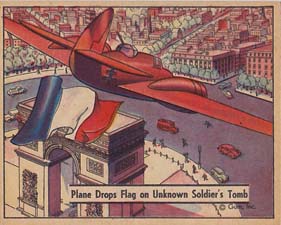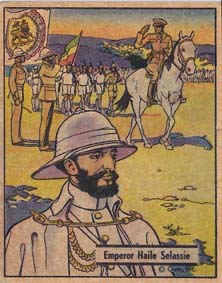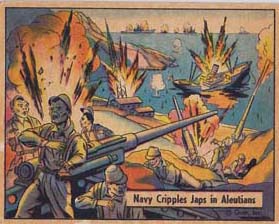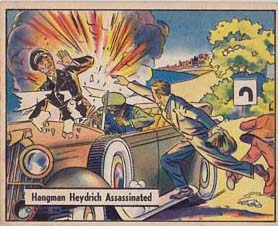The Wonders of War Gum!
By Kurt Kuersteiner ©2012 Monsterwax
Monster Trading Cards for
The Wrapper Magazine
Almost every vintage card collector knows and loves Horrors of War. But what about its younger stepsister, War Gum? Why is it so often ignored? The two series have a lot in common: They were both produced by the creative team of Warren Bowman (publisher) and George Moll (advertising executive). They both reported true events of the (then current) 2nd World War. They were both large series released in segments as new events transpired. And yet, Horrors of War (H.o.W) hogs most the attention while War Gum usually hangs around like a wallflower.
Who knows why the average guy falls in love with this over that? (I still can’t explain the public dumping Paris Hilton for Kim Kardashian.) Nevertheless, a closer look at this oft’ ignored gem is certainly warranted. It has so much going for it.
Some folks disparage War Gum because it doesn’t have the gore that H.o.W does. True. But that doesn’t mean it has no blood and guts. There are numerous action scenes and the explosive tales they tell on the back are very compelling. But the emphasis of War Gum is to highlight the bravery of our soldiers, rather than the atrocities of the enemy. It’s almost as if Bowman, satisfied that he had adequately nudged America into the war, was determined to downplay the gore and focus more on the glory of war. In fact, that title would seem even more appropriate for this series: Glory of War.

Numerous soldiers are profiled, including high profile generals, as are famous leaders like FDR and Churchill. Their portraits tend to crowd out most of the background action. Yet the information on the backs is often quite revealing. For instance, did you know that Churchill’s mother was an American? (I don’t remember learning that in history class. Then again, I don’t remember history class…)
As far as the profiles go, there are 38 of them. The soldier or hero’s face usually takes up half the card, with some sort of fight scene usually taking place behind them. That means the other 98 cards are typically full battle scene cards, although they do use up some space to paste the title on the front.
One of the most popular profiles is that of General MacArthur (#11). It always seems to cost more than other cards in the series, although other “celeb” profiles (FDR & Churchill) also command premiums as well. The card says, “When the Japs made their dastardly attack on the Philippines on December 7, 1941, the General placed his entire command on the alert.” Not exactly a ringing endorsement. The next MacArthur card (#62) features him making “a dash” to Australia. His retreat is described as “one of the most stirring adventures of the war.” (At least they didn’t call it “daring”!)
One of my favorite profile cards is #17, The Chiangs. Talk about hyperbole. The card claims, “Generalissimo Chiang Kai-shek and his American educated wife stand for modern China and its progress. It is largely through their brave and untiring efforts that the Chinese people have been united and the onslaught of the enemy invaders held in check. Today China is organizing one of the biggest and best trained armies in the world…” United? China was fighting a civil war with the communists (a war it eventually lost). And one of the “best trained armies in the world”? Check out your H.o.W cards and see how they fared with their garden tools and other “weapons” against machine guns. Still, it mentions the Chinese were expecting the war to last 20 years, but that time meant nothing to them as long as victory was assured. That’s sobering. America is lucky to keep fighting beyond one presidential term!
Another favorite profile card is #99: Emperor Haile Selassie. Few card collectors realize what a character this Ethiopian ruler really was. For starters, he was born heir to a dynasty that goes back to the 13th century, and according to tradition, all the way back to the Queen of Sheba. He is also considered the return of the Biblical Jesus, according to the Rastafarians. (That, and smoking weed, are two popular subjects of Reggae music.) When Italy attacked Ethiopia, Selassie led the government in Exile. After the war, he became the longest lasting African leader until a famine killed 40,000 to 200,000 of his subjects from 1972-1974. A communist backed revolution deposed him in 1974, and executed 60 of his highest officials without trials. Selassie was allegedly murdered by them while under house arrest a year later. According to Reggae and the Rastafarians, however, he is still alive.

Several of the cards are not really “profiles” but showcase the courage of soldiers or heroes nonetheless—even if their names are unknown. One such example is #129: Negro Swimmer Tows Survivors. It tells the tale of how a sinking Destroyer left a raft of wounded seamen drifting seaward. A black mess attendant stripped off his clothes and jumped into the ocean. He pulled the tow rope and raft for six hours through shark infested waters until they were spotted and rescued. The survivors only knew his first name: French.
Being that this series was issued in the early part of the war (the copyright says 1941, but since war was declared on Dec. 7th of that year, it’s more likely 1942 for the earlier cards and 1943 for the later ones.) The text itself reflects events that occurred as late at October 1942 (card #129). Unlike the war itself, the cards mainly focus on the conflict in the Pacific. America actually devoted most of its resources toward defeating Germany first, putting off Japan until after victory in Europe. This is not to say the fighting wasn’t fierce in the Pacific—the Japanese were far more vicious and suicidal than the Germans were fighting our soldiers, and they killed ten times more P.o.W.s than the Nazis—but the feeling was that Germany was consolidating its grip on Europe faster than the Japanese were in Asia, and therefore, our priority should be Europe.
Ironically, there is a continued debate as to whether or not Roosevelt provoked war with Japan in order to have war with Germany. He had publically promised to keep us out the war, but his lend lease program of March 1941 ended any pretense of neutrality as it gave enemies of the Axis $50 billion in direct military aid. He ordered the Navy to shoot “on sight” any German submarines beginning Sept. 11th. There was also the McCollum memo, an 8-point intelligence plan to engineer a situation that would mobilize a reluctant America into war. President Roosevelt began following its recommendations Oct. 10th, 1940. It included a commercial blockade of Japan, and building bases in unprotected Hawaii, tempting an attack. When Admiral J.O. Richardson became suspicious of this plan, he was fired and replaced by Admiral Kimmel, who was denied access to Japanese intercepted messages. Four such cablegrams were delivered to FDR twelve hours before the attack, one of them revealing the planned assault on Pearl Harbor three hours before it occurred. However, FDR gave no warning to Kimmel. According to the President’s aide, Lt. Commander Rochefort, the loss of 2,472 soldiers was a “pretty cheap price to pay” to unify the country. And he may have been right. 88% of Americans were opposed to entering the war until after we were attacked. Likewise, Churchill himself knew of numerous German attacks before they occurred, but rather than risk revealing that the English had broken the German code, he let the civilians (and allies) suffer without any advance warning.

But these are dirty details the public didn’t know for decades (and it would have damaged morale if they found out during the war). Instead, War Gum highlights the good, not the bad and the ugly. That was one of the nicer things about America back then. It didn’t want the ugly. In fact, most Americans didn’t even know Roosevelt was wheelchair bound. His opponents didn’t mention it, and neither did the news. (Gone are those days!)
Not only is the artwork of War Gum by the same talented group of artists as H.o.W, but the stories on the back are just as interesting. A good example is card #10:
“From the first day of the war the brave Marines on Wake Island had beaten off attack after attack of Japanese by shooting down their planes, sinking their ships. The crew of the Philippine ‘Clipper’ was at Wake when the first attack came. Jap planes bombed and strafed the construction, camp, the docks and fuel installations. The ‘Clipper’ was ordered back to Honolulu, but the Marines stubbornly continued to resist. They sank a Jap cruiser and a destroyer. Later five more Jap ships went down under their fire! When contacted by the Navy officials and asked if there was anything they wanted their response was, ‘Yes, send us some more Japs!...’”
Not mentioned on the card is that the Marines were eventually forced to surrender. They lost just 49 men, while the Japanese lost 700 to 900. However, 98 American workers were also captured and forced into slave labor. They were executed by the Japanese on October 5, 1943, as retaliation for a raid by the U.S.S. Yorktown.
Another favorite propaganda type card is #37: Japs Kill U.S. Hero Bailing Out. It tells how Lt. Anderson had shot down a Japanese plane during an aerial dog fight, but sustained damage in the process and bailed out. “Two enemy planes followed him toward the ground. They riddled his parachute with machine gun bullets, and while he was still helplessly falling earthward, an enemy pilot shot him through the heart. Still not satisfied, one enemy plane returned to machine-gun the crumpled body on the ground!” Okay boys and girls, which side is the bad side of this war? Just checking…
Like H.o.W, only a handful of these cards feature Nazis. There are no Hitler cards in War Gum, but there is dramatic one called Hangman Heydrich Assassinated. Like many of the cards, the information on the backs was misleading or incomplete. Reinhard Heydrich was the #2 Gestapo Chief (below Himmler). He was put in charge of Czechoslovakia and mortally wounded by Czech assassins. The card blames his murder on Czech discontent over his ruthless policies, but it was actually the other way around. Heydrich was assassinated because he had successfully undermined Czech resistance by using a carrot and stick approach, including labor reforms, fewer work days, and stomping out the black market. (It’s scary to see how cheap some will sell their freedoms.) To end this threat, the Czech Gov’t in Exile worked with British Intelligence to train, equip, and smuggle two agents back into the country to kill him. They were banking on fierce reprisals to re-energize the resistance. What wasn’t intended was that the British machine gun would jam when Heydrich’s car drove by. Not one to flee, however, Heydrich ordered his car to stop to fight the assassins himself. They threw a bomb at the car that ripped open his back. He emerged from the smoke with his pistol drawn and chased the two killers down the road until he fell into shock from blood loss. He eventually went into a coma and died from infection. This bit of dumb luck was spun as a daring attack by the Czech resistance. Not realizing it was an outside job, Hitler took the bait and had 1,300 locals killed in reprisals. And thus, the Czech resistance was finally back in business.

So while no one is advocating we should learn our history from these (or any) cards, they are excellent starting points to understanding the public perception of the war during the time it raged. Indeed, that’s one of the neatest things about this set: it was produced during the actual conflict. (Horrors of War was also made during the war--but before America entered it.) The war itself is likely what killed the production of these cards, as demand for paper limited the manufacture of all cards. So if you want a real war souvenir, you would have a tough time coming up with something more colorful, eye grabbing, and dramatic than War Gum.